THEME: VINTAGE
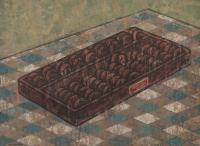 He Jian is notable for his amalgamation of ancient and contemporary Chinese culture. Rather than painting in oil like most of his contemporaries, he uses rice paper, dry pigment, and binder as his media. He strategically layers and manipulates his paints to take on the timeworn quality of the 14th century Yuan Dynasty frescoes at the Yong Le Temple in Shanxi Province. He Jian uses this distinctive new-old, antiquated style to present a wide range of quotidian subject matter. Although many of his works portray figural groups engaged in activities characteristic of modern Chinese life, in this series He Jian directs his focus towards utilitarian objects that signaled China’s shift towards a consumer culture. The cheap electronics that have dominated Chinese manufacturing in the past two decades have all but obliterated use of the abacus, a traditional Asian counting tool. But it was only as recently as the 1990s when virtually every shopkeeper in the mainland used one. In a short span of time, the abacus has already become a forgotten object, and both He Jian's stylistics and subject matter are informed by this nostalgia.
He Jian is notable for his amalgamation of ancient and contemporary Chinese culture. Rather than painting in oil like most of his contemporaries, he uses rice paper, dry pigment, and binder as his media. He strategically layers and manipulates his paints to take on the timeworn quality of the 14th century Yuan Dynasty frescoes at the Yong Le Temple in Shanxi Province. He Jian uses this distinctive new-old, antiquated style to present a wide range of quotidian subject matter. Although many of his works portray figural groups engaged in activities characteristic of modern Chinese life, in this series He Jian directs his focus towards utilitarian objects that signaled China’s shift towards a consumer culture. The cheap electronics that have dominated Chinese manufacturing in the past two decades have all but obliterated use of the abacus, a traditional Asian counting tool. But it was only as recently as the 1990s when virtually every shopkeeper in the mainland used one. In a short span of time, the abacus has already become a forgotten object, and both He Jian's stylistics and subject matter are informed by this nostalgia.
Click on the artwork for more information-
$35.00
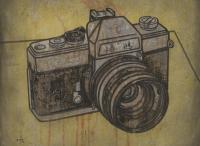 He Jian is notable for his distinctive amalgamation of ancient and contemporary Chinese culture. Rather than painting in oil like most of his contemporaries, he uses rice paper, dry pigment, and binder as his media. He strategically layers and manipulates his paints to take on the timeworn quality of the 14th century Yuan Dynasty frescoes at the Yong Le Temple in Shanxi Province. He Jian uses this distinctive new-old, antiquated style to present a wide range of quotidian subject matter. Although many of his works portray figural groups engaged in activities characteristic of modern Chinese life, in this series He Jian directs his focus towards utilitarian objects that signaled China’s shift towards a consumer culture. Seagull, the first camera maker in China founded in 1958, released the DF series seen here in 1964, and today, its image instantly conjures nostalgia for the time period. He Jian's painting melds the stylistics of classical China with a subject that heralds its recent history in paintings that negotiate the separate but continuous histories that inform China's present.
He Jian is notable for his distinctive amalgamation of ancient and contemporary Chinese culture. Rather than painting in oil like most of his contemporaries, he uses rice paper, dry pigment, and binder as his media. He strategically layers and manipulates his paints to take on the timeworn quality of the 14th century Yuan Dynasty frescoes at the Yong Le Temple in Shanxi Province. He Jian uses this distinctive new-old, antiquated style to present a wide range of quotidian subject matter. Although many of his works portray figural groups engaged in activities characteristic of modern Chinese life, in this series He Jian directs his focus towards utilitarian objects that signaled China’s shift towards a consumer culture. Seagull, the first camera maker in China founded in 1958, released the DF series seen here in 1964, and today, its image instantly conjures nostalgia for the time period. He Jian's painting melds the stylistics of classical China with a subject that heralds its recent history in paintings that negotiate the separate but continuous histories that inform China's present.
Click on the artwork for more information-
$35.00
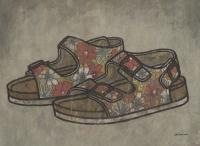 Artist He Jian is notable for his amalgamation of ancient and contemporary Chinese culture. Rather than painting in oil like most of his contemporaries, He Jian uses rice paper, dry pigment, and binder as his media. He strategically layers and manipulates his paints to take on the timeworn quality of the 14th century Yuan Dynasty frescoes at the Yong Le Temple in Shanxi Province. He Jian uses this distinctive new-old, antiquated style to present a wide range of quotidian subject matter. Although many of his works portray figural groups engaged in activities characteristic of contemporary Chinese life, in this series He Jian directs his focus towards utilitarian objects that signal China’s shift towards a consumer culture. In this painting, He Jian depicts a pair of floral sandals. The anachronistic depiction of this footwear suggests its elevation to the same level as the Taoist deities that line the walls of Yong Le Temple. He Jian's painting melds the style and flavor of ancient China with a subject that heralds its recent history, visualizing the complex dialogue between ancient and contemporary Chinese culture.
Artist He Jian is notable for his amalgamation of ancient and contemporary Chinese culture. Rather than painting in oil like most of his contemporaries, He Jian uses rice paper, dry pigment, and binder as his media. He strategically layers and manipulates his paints to take on the timeworn quality of the 14th century Yuan Dynasty frescoes at the Yong Le Temple in Shanxi Province. He Jian uses this distinctive new-old, antiquated style to present a wide range of quotidian subject matter. Although many of his works portray figural groups engaged in activities characteristic of contemporary Chinese life, in this series He Jian directs his focus towards utilitarian objects that signal China’s shift towards a consumer culture. In this painting, He Jian depicts a pair of floral sandals. The anachronistic depiction of this footwear suggests its elevation to the same level as the Taoist deities that line the walls of Yong Le Temple. He Jian's painting melds the style and flavor of ancient China with a subject that heralds its recent history, visualizing the complex dialogue between ancient and contemporary Chinese culture.
Click on the artwork for more information-
$35.00
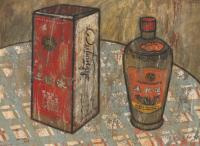 He Jian is notable for his distinctive amalgamation of ancient and contemporary Chinese culture. Rather than painting in oil like most of his contemporaries, he uses rice paper, dry pigment, and binder as his media. He strategically layers and manipulates his paints to assume the timeworn quality of the 14th century Yuan Dynasty frescoes at the Yong Le Temple in Shanxi Province. He Jian uses this distinctive new-old, antiquated style to present a wide range of quotidian subject matter. Although many of his works portray figural groups engaged in activities characteristic of modern Chinese life, in this series He Jian directs his focus towards utilitarian objects that signaled China’s shift towards a consumer culture.
He Jian is notable for his distinctive amalgamation of ancient and contemporary Chinese culture. Rather than painting in oil like most of his contemporaries, he uses rice paper, dry pigment, and binder as his media. He strategically layers and manipulates his paints to assume the timeworn quality of the 14th century Yuan Dynasty frescoes at the Yong Le Temple in Shanxi Province. He Jian uses this distinctive new-old, antiquated style to present a wide range of quotidian subject matter. Although many of his works portray figural groups engaged in activities characteristic of modern Chinese life, in this series He Jian directs his focus towards utilitarian objects that signaled China’s shift towards a consumer culture.
In this painting, He Jian takes the most renowned brand of Chinese grain liquor, Wuliangye, as his subject. Made from a five-crop blend (broomcorn, rice, glutinous rice, wheat, and corn), Wuliangye is known within every household in China but not without, where the stiff liquor has yet to win over drinkers. The liquor in He Jian's painting is depicted with a nostalgic touch, and Wuliangye is a heritage brand as much a part of China's lived history as anything in history books.
Click on the artwork for more information-
$35.00
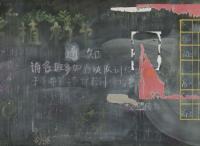 Do you remember your classroom blackboard? Chen Jiao takes us back to our first years of school: a glimpse into the world of language and letters, equations and charts. With layers of colorful accents, the childlike trees and found paper, she refers to her own childhood in southern China. The grey wash over the board mimics the grey sky of her industrial town; the trees evoke the trails where she discovered new pathways on long walks. The characters on the board remind the students of their post-Cultural Revolution identities as coexisting workers, yet the yellow chart creates a rating system for a spectrum of students. It is the paradox of Chinese education: how do you distinguish yourself when you must also live as one small part to a whole? No matter where you are from, Blackboard – Jintang Middle School, by Chen Jiao touches on the universalism of learning and its ability to shape both a society’s and child’s memories.
Do you remember your classroom blackboard? Chen Jiao takes us back to our first years of school: a glimpse into the world of language and letters, equations and charts. With layers of colorful accents, the childlike trees and found paper, she refers to her own childhood in southern China. The grey wash over the board mimics the grey sky of her industrial town; the trees evoke the trails where she discovered new pathways on long walks. The characters on the board remind the students of their post-Cultural Revolution identities as coexisting workers, yet the yellow chart creates a rating system for a spectrum of students. It is the paradox of Chinese education: how do you distinguish yourself when you must also live as one small part to a whole? No matter where you are from, Blackboard – Jintang Middle School, by Chen Jiao touches on the universalism of learning and its ability to shape both a society’s and child’s memories.
Click on the artwork for more information-
$35.00








